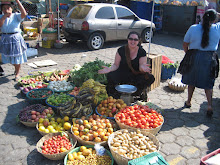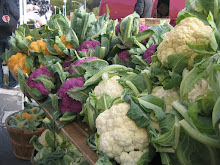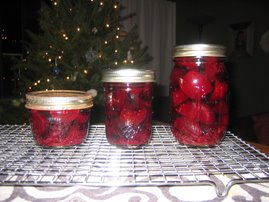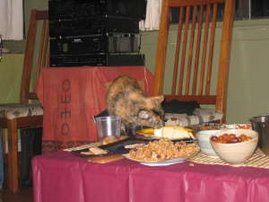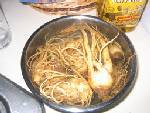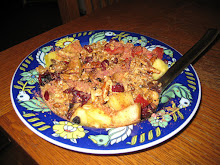 |
| Beautiful challah loaf |
 |
| toasted challah cubes |
The title of this post is "Ceasefire Stuffing" because today, after 8 days of sustained violence in Gaza, Israel and the Palestinians agreed to a ceasefire, and I combined challah bread with pork for my Thanksgiving stuffing. Clearly, the two events are not at all comparable: the former being a critical global event that will save countless lives and the latter a simple tasty dish. But the blog post needed a title, and the dish needed a name.
 |
| pork sausage, removed from its casing, with fresh thyme. |
There are some foods that are just designed to go together, and apple, sage, sausage, and leek are like a close knit group of friends--they are so good together--in a soup, a stir fry, and best of all, a stuffing. Thankfully no vegetarians this year, but I guess you could substitute a vegetarian tofu sausage, or even leave the meat out altogether. The smell of this dish cooking, as Julia Child would say, will make you feel like home.
Ceasefire Stuffing
Challah Stuffing with Apple, Leek & Sausage
1 large loaf of challah bread
2 large leeks, chopped
3 celery stalks, chopped
8 oz mushrooms, chopped
4 apples, diced
4-5 sausages or ground pork*
1-2 tbsp chopped fresh thyme
3 tsp sage
1 tsp salt
1 tsp cracked black pepper
3 cups chicken or vegetable stock
4 tbsp melted butter
1 beaten egg
*spicy, sweet, seasoned or not, depending on your taste.
Cut the bread into 1" or 1/2" cubes, depending on how you like your stuffing. Spread out evenly on cookie sheets and toast at 250 F until dry.
Saute the chopped leeks and celery in a cast iron pan with some olive oil until soft. Add the mushrooms, apples, sage, salt & pepper and cook until the apples are tender.
Transfer the leek-apple mixture to a very large bowl. By this time, your bread should be done. Take it out and set it aside. In the same cast iron pan, saute the pork and thyme. When the meat is nicely browned, transfer to the bowl with the leek-apple mixture. Melt 4 tbsp butter in the pan you've just taken the meat out of; add the melted butter to the meat-veggie mixture. Stir in the stock. And then, when the mixture has reached room temperature, add in the beaten egg.
 Carefully stir the toasted bread cubes into the meat-veggie mixture a little bit at a time to fully coat the bread with the mixture. Stir together until everything is incorporated. Pack the stuffing into a casserole dish, cover, and bake at 350 F for 30-40 minutes. Uncover the stuffing for the last 5 minutes and turn up the heat to 400 F to brown the top. You can also prepare the stuffing the night before and pop it into the oven the next day before dinner.
Carefully stir the toasted bread cubes into the meat-veggie mixture a little bit at a time to fully coat the bread with the mixture. Stir together until everything is incorporated. Pack the stuffing into a casserole dish, cover, and bake at 350 F for 30-40 minutes. Uncover the stuffing for the last 5 minutes and turn up the heat to 400 F to brown the top. You can also prepare the stuffing the night before and pop it into the oven the next day before dinner.
Enjoy!
The key to this dish, I think, is the careful way you have to fold the wet ingredients into the dry. Don't be afraid to use the butter--your guests will appreciate it. I was worried that the stuffing would be too wet with all of the stock, butter, and egg, but once you bake it, this liquid will ensure that your stuffing is moist and holds together. This recipe made quite a bit of stuffing, but we're having 8 with healthy appetites for dinner, and I hope there's some left over for turkey sandwiches!
Challah Stuffing with Apple, Leek & Sausage
1 large loaf of challah bread
2 large leeks, chopped
3 celery stalks, chopped
8 oz mushrooms, chopped
4 apples, diced
4-5 sausages or ground pork*
1-2 tbsp chopped fresh thyme
3 tsp sage
1 tsp salt
1 tsp cracked black pepper
3 cups chicken or vegetable stock
4 tbsp melted butter
1 beaten egg
*spicy, sweet, seasoned or not, depending on your taste.
Cut the bread into 1" or 1/2" cubes, depending on how you like your stuffing. Spread out evenly on cookie sheets and toast at 250 F until dry.
Saute the chopped leeks and celery in a cast iron pan with some olive oil until soft. Add the mushrooms, apples, sage, salt & pepper and cook until the apples are tender.
Transfer the leek-apple mixture to a very large bowl. By this time, your bread should be done. Take it out and set it aside. In the same cast iron pan, saute the pork and thyme. When the meat is nicely browned, transfer to the bowl with the leek-apple mixture. Melt 4 tbsp butter in the pan you've just taken the meat out of; add the melted butter to the meat-veggie mixture. Stir in the stock. And then, when the mixture has reached room temperature, add in the beaten egg.
 Carefully stir the toasted bread cubes into the meat-veggie mixture a little bit at a time to fully coat the bread with the mixture. Stir together until everything is incorporated. Pack the stuffing into a casserole dish, cover, and bake at 350 F for 30-40 minutes. Uncover the stuffing for the last 5 minutes and turn up the heat to 400 F to brown the top. You can also prepare the stuffing the night before and pop it into the oven the next day before dinner.
Carefully stir the toasted bread cubes into the meat-veggie mixture a little bit at a time to fully coat the bread with the mixture. Stir together until everything is incorporated. Pack the stuffing into a casserole dish, cover, and bake at 350 F for 30-40 minutes. Uncover the stuffing for the last 5 minutes and turn up the heat to 400 F to brown the top. You can also prepare the stuffing the night before and pop it into the oven the next day before dinner.Enjoy!



































